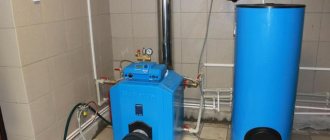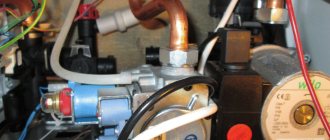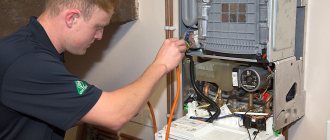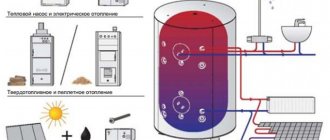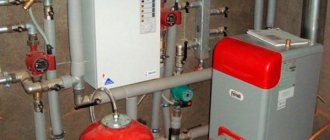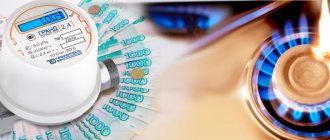Gas consumption metering
It is generally accepted that a person consumes on average about 10 cubic meters. meters of gas per month. To set the exact figure you need a counter. Installing meters allows you to save money, since a person only pays for what his family has used. This is especially true for residents of apartment buildings, where gas is used exclusively for cooking.
We recommend reading: Is it worth using various frauds with the counter and what it could mean?
For private houses connected to a central gas supply, installing meters is no less important. This is due to the need to take into account gas consumption for heating, hot water supply and household appliances (for example, a gas stove).
Requirements for counters:
- compliance of equipment with acceptable use standards;
- installation is carried out by specially trained people;
- After installation, sealing must be carried out;
- Each gas meter has its own operating period, after which the device is checked and, if necessary, replaced.
The consumer must record the meter readings every month before the 10th day. Then the gas consumed is calculated by comparing the current data with the volume of consumption of the previous month. The owner of the meter pays for the amount of fuel he used.
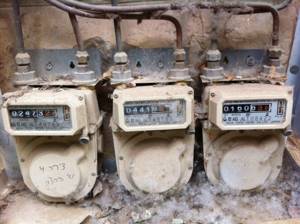
If the consumer does not send his meter readings on time, then average values are used for calculation. If data has not been transmitted within 3 months, then the total indicators for the past year are taken and divided by the number of months. When the period for transferring indicators exceeds 90 days, the standards will be applied for calculation.
If the meter is equipped with temperature compensation, the difference between the current value and the previous one is calculated. When the gas meter is located outdoors and does not have temperature compensation, then in order to bring the readings to normal conditions, the resulting difference between the volumes of fuel consumed must be multiplied by the temperature coefficient.
Gas tariffs in 2021 with a meter
Tariffs are constantly increasing from year to year. If you compare gas prices with previous years, the difference is significant. Each region sets different tariffs for utility bills.

The tariff for cooking and heating water using a gas stove and heating water using a gas water heater in the absence of hot water supply for the Moscow region is 5.70687 rubles per m3. In St. Petersburg and the Leningrad region, the tariff is 6.55878 and 6.60481 rubles, respectively. In Yekaterinburg and the Sverdlovsk region you will have to pay 4.98 rubles per cubic meter, and in Krasnodar – 6.43 rubles.
The cost of gas in Novosibirsk is 6.124 rubles, and in Omsk – 6.51 rubles. The price of fuel in the Perm region is 6.12 rubles, and in Rostov – 6.29 rubles. For Samara and Saratov, the indicators are measured as 6.2 and 9.2, respectively. In Nizhny Novgorod the cost of gas is 5.7916 rubles, and in Ufa – 6.71 rubles.
For Crimea, the standards depend on the amount of gas consumed. If more than 3,500 cubic meters of fuel were consumed per year, then 1 cubic meter will cost 8.65271 rubles, and if less - 5.56151 rubles.
Meters for measuring fuel consumption
The meter measures the amount of gas at different conditions of temperature and pressure and, using special equipment, brings the result to the indicator that will be under standard conditions (SU) - +20 °C and 101 kPa.
The volume of fuel for the control system is determined by the formula Vс = V×(p×Tс/pс×T×K) , where
- V is the volume of gas;
- p—density;
- T—thermodynamic temperature;
- K is the fuel compressibility coefficient.
Values with the letter “c” are indicators for standard conditions, without - for workers.
In everyday life, membrane, rotary and ultrasonic meters are used, in large enterprises - turbine and vortex meters - these are the most popular types of gas meters. In gas industry plants, volume is determined mainly by variable pressure changes in constrictions, often between 2 flange connections in close proximity. The meters differ in their operating features.
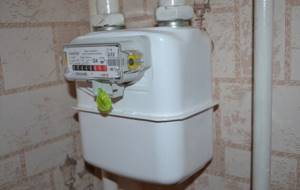
The image shows a classic membrane meter (diaphragm, chamber), in the compartments of which there are membranes that move from the movement of gas and determine its volume
Diaphragm flowmeters provide minimal calculation errors and consume little electricity. The devices provide readings over a wide range, but with a low maximum pressure - up to 0.5 bar. In everyday life, the meter performs best, since the calibration interval reaches up to 10 years with high reliability of the device. The design does not respond well to mechanical gas contamination and is generally very bulky.
Rotary, or rotary , models do not depend on the electrical network; they are suitable for small industrial facilities, but they are less convenient. With a small installation area and high precision under conditions of sudden pressure changes, they make noise and more often fail. They are “afraid” of pneumatic shocks and pollution.
Ultrasonic meters are small in size and vary significantly in the complexity of their structure. Acoustic gas meters are valued for their reliability and ease of installation. Some devices contain non-volatile memory. Meters for standard sizes G1.6 and G2.5 are relatively expensive.
Turbine devices are used to measure the amount of household and aggressive gases and multicomponent compositions. Meters have become widespread at gas pipelines and chemical plants. Turbine devices record large quantities of gas at pressures up to 10 MPa and vary significantly in size and operating pressure. These are universal instruments for measuring natural gas flow in industry.
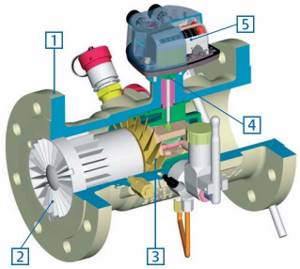
The turbine meter is a fragment of a pipe: in Figure 1 - housing, 2 - gas flow rectifier, 3 - measuring mechanism with a turbine, 4 - magnetic coupling for transmitting rotation to the counting mechanism, 5 - counting mechanism
Vortex meters measure the volume of natural or inert gases. In terms of measurement range they have an advantage over other models. They detect the slightest movements in the gas mixture and determine large quantities of gas per diameter. The efficiency of a vortex flow meter is directly proportional to the fuel flow rate.
Measurement methods used in gas flow meters
Fuel consumption is calculated using direct and indirect methods.
In the case of direct gas, gas fills the measuring chambers and leaves them. The volume passed correlates with the filling-emptying cycles. Counting in membrane, rotary and drum counters works according to the described principle.
Gas meters with an indirect measurement method work with speed indicators and a known cross-sectional area. The counting method can be mechanical or other, related to the characteristics of the counter. In mechanics, turbines, impellers, and balancing elements are used.
The indirect method of calculation has other methods:
- vortex detection;
- measuring the pressure difference on the constriction device;
- calculation of heat transfer from a heated body;
- measurement of velocity pressure;
- counting based on ultrasonic movement.
The correctness of indirect methods depends on the correspondence of the speed in direction and cross-section. Flow preparation means help: turbulators, condensers and flow straighteners. The devices come separately or as elements of meters.

The principle of operation of a vortex gas meter: a streamlined body has a balancing element, due to which vortices alternately pass from the right to the left - the sensor will not record anything if the gas speed drops to a value at which vortices are not formed
The devices can determine the difference in speed across the cross section simultaneously with the speed of gas movement and thus reduce the error. The latter often occurs due to fuel stagnation near the walls. Read more about direct and indirect methods for determining gas consumption below.
How is gas pressure determined?
Pressure is measured directly using pressure gauges or by adding the values of atmospheric (Pb) and excess pressure (Pi). Pb is measured at the location of the Pi converter, if the latter is in a closed space and there is pressure or vacuum in it.
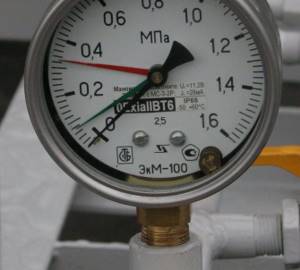
Pressure gauges measure pressure and indirectly the speed of gas movement, which helps determine the amount of fuel consumed, as well as calculate the benefits of the meter
The pressure tapping hole for vertical and horizontal pipes is placed radially. On a transverse pipeline it is located in the upper half of the section.
In flow meters without the specified hole, sampling is carried out in front of the meter, at a distance of 1 to 3 pipeline diameters, with a reference point from the gas meter inlet flange.
Accounting for gas consumption without using meters
Gas consumption is calculated for each person registered in the house. Indicators are calculated based on the volume of the apartment or house. There are also special applications that help determine the consumption of blue fuel online for homes where metering devices are not installed.
Gas consumption standards per person without a meter by region
The rate of gas consumption per person depends on the operating conditions of gas appliances, as well as on the region of consumption of blue fuel. For example, if there is central heating and central hot water supply, the norm per person in the Moscow and Novosibirsk regions will be 10 cubic meters per person per month. In the Leningrad region this figure is 13 cubic meters. For Yekaterinburg the norm is 10.2 m3, and for Omsk – 13.06.
Gas consumption standards per person for houses without a meter in Krasnodar and Crimea are measured as 11.3 cubic meters. For Perm, Ufa, the Republic of Bashkortostan the figure is 12 cubic meters, and for Rostov-on-Don and Samara - 13. The norm for Saratov is 11.5 cubic meters, and for Nizhny Novgorod - 11.
By meter
If the residential premises are equipped with an individual meter, it is important for the owner to record the data correctly and in a timely manner so as not to make mistakes in calculating the amount of monthly payments. This method of payment is much more profitable than when using standards, since in this situation the use of increasing coefficients is excluded
The owner pays exclusively for the volumes consumed during the month. As a result, the amount will be significantly lower than when calculated according to the standards
This method of payment is much more profitable than when using standards, since in this situation the use of increasing coefficients is excluded. The owner pays exclusively for the volumes consumed during the month. As a result, the amount will be significantly lower than when calculated according to the standards.
Sequence of readings
The meter data is taken in the following order:
- Every month, between the 20th and 25th, the current number of cubic meters on the meter is read;
- The information received is recorded by the consumer and transmitted to the utility organization supplying the resources;
- Readings are recorded without taking into account the leading zeros and fractional fractions of cubic meters;
- The readings taken a month earlier are subtracted from the obtained value;
- The result is multiplied by the tariff established in the region.
It is very important to take the data in a timely manner and report the readings to the utility company. Otherwise, the information may not be taken into account when assigning an invoice for payment.
The procedure for determining gas consumption standards
Calculation of standards is carried out by government authorities of the Russian Federation. The specifics of establishing standards are regulated by the orders of the Regional Energy Commission. The permissible amount of gas consumed depends on the different uses of the fuel. Different formulas are used for each purpose of gas use.

Types of gas consumption:
- cooking;
- heating water using a gas water heater or on a stove (this option is used when there is no central water supply);
- heating (when there is no central line for heating the house).
Consumption rates for liquefied and natural gas are calculated using different methods. In private houses, outbuildings are heated using blue fuel; when establishing standards, the area of the premises, the presence and number of animals, the number of citizens registered on the site, and connection to central highways are taken into account. The formula also depends on the type of gas - natural or liquefied.
We recommend: How much does liquefied gas delivery cost?
Fuel consumption can be recalculated using a special online calculator. It is enough to enter the initial data, and the program itself will select the formula.
Gas... and other gas
Blue fuel has been the most popular and cheapest energy source for many years. Most often, two types of gas are used for heating and, accordingly, two connection methods:
- Magistralny . This is methane purified from impurities with the addition of a tiny amount of fragrance to facilitate leak detection. Such gas is transported through gas transportation systems to consumers.
- A liquefied mixture of propane and butane, which is pumped into a gas holder and provides autonomous heating. When this liquid transforms into a gaseous state, the pressure in the tank increases. Under high pressure, the gas mixture rises through pipes to the point of consumption.
Both types have their pros and cons:
- When connecting to a main line, there is always a danger of pipeline breakage and a decrease in pressure in it. The gas tank provides complete autonomy; you only need to monitor the availability of gas;
- gas tank equipment and its maintenance are expensive . But this is the only possibility of gas heating if there is no mains in the accessible vicinity;
- To calculate the gas consumption for heating a house of 100 sq. m, a comparison is made of the calorie content of the fuel from the main line and the liquefied mixture in the cylinder. The calorie content of a propane-butane mixture is three times greater than that of methane: the combustion of 1 m3 of the mixture produces 28 kW, and the combustion of the same amount of methane produces 9 kW. Accordingly, different amounts will be spent on heating the same area.
The liquefied mixture is often pumped into small containers for autonomous heating.

For autonomous heating, liquefied gas in cylinders is also used Source blog.mybacharach.com
See also: Catalog of companies that specialize in home insulation services.
Tariff increase program
The Russian government has developed a program to increase tariffs for all utilities. Thus, at the end of 2021, the cost of liquefied gas increased by 4.1%. A significant increase in tariffs awaits the northern regions of the Russian Federation, since it is more difficult to transport fuel to these regions. Consumers should expect the next increase in gas prices in mid-2021.
Gas tariff increases for households and businesses are different, for example:
- For ordinary citizens, gas prices will increase by 8.5%;
- For industrial companies, the cost of fuel will increase by 7.5%.
Initially, the government planned to increase tariffs by 5.5%. But inflation leads to an accelerated rise in the cost of utility services. At the same time, the problem of the population's debt for gas is not being solved. As of 2021, the debts of the population amounted to more than 60 billion rubles.
How to pay less
Since you won’t be able to significantly win in price by installing autonomous heating, you need to turn to energy-saving technologies.
- Carry out thorough insulation of not only the walls of the building, but also the roof, floor, foundation, even the basement, if there is one.
- Replace double-glazed windows with energy-saving ones, the profile is frost-proof.
- Install a boiler with maximum efficiency and an electronic thermostat.
- Check the condition of the house's thermal insulation using a thermal imager to identify cold spots and eliminate them.
- Change the ventilation and air conditioning system. Just an open vent or a window set for ventilation takes in more heat than a window opened for 5-7 minutes and a complete change of air in the room.
- Install heated floors , especially in hallways and hallways.
- Install electronic sensors to block heating above the set temperature.
It is very effective to use the smart home system, which will reduce gas consumption by at least 25%. If you follow all the tips, your home will be warm and cozy, and your gas bills won’t be terrible.

The smart home system is easier and more comfortable to control using a remote control Source archidom.ru
Debt
Many consumers do not pay utility bills. Changes in gas prices have no effect on the debt problem. Experts say that some categories of citizens refuse to pay for gas not because of rising fuel prices, but because of personal convictions.
The authorities regularly introduce various programs to encourage the population to pay for utilities. Regarding gas supply, consumers are required to pay their bills every month by the 10th of the month. If a citizen stops making payments, he will be fined. The amount of collections is 17.7% of the annual debt.
We recommend reading: Is it possible to get away with just a fine for non-payment and for unauthorized connection to gas
The debtor begins to be fined after three months of non-payment. The state provides penalties for companies that provide public services. If such companies use low-quality fuel or supply gas irregularly, they must pay 1/170 of the refinancing.
